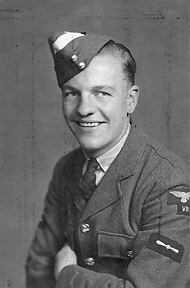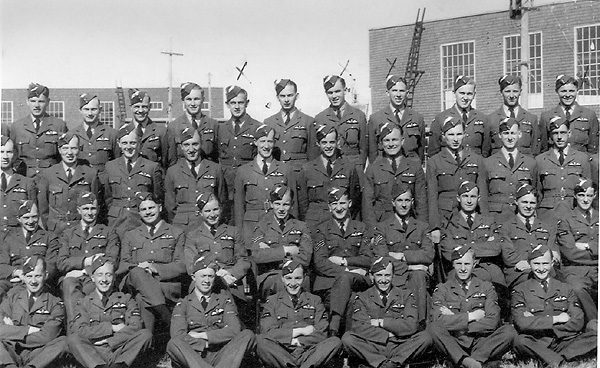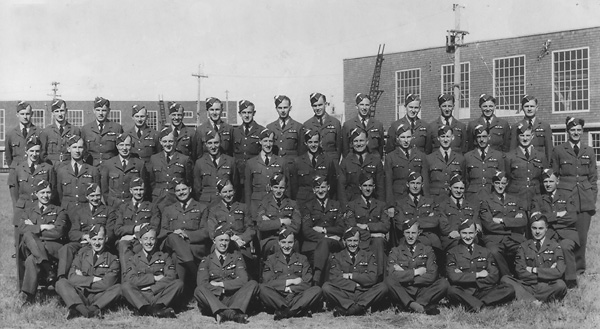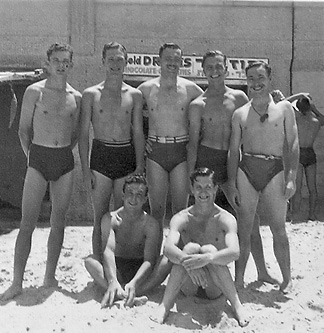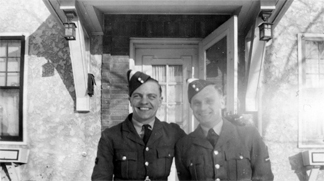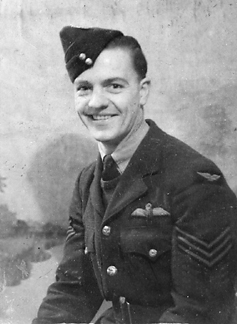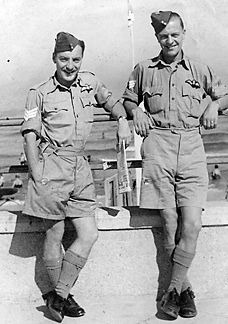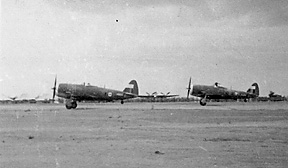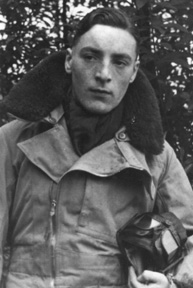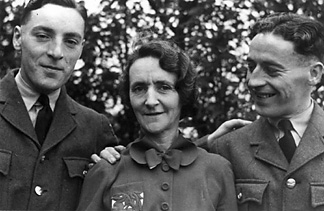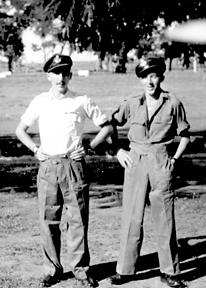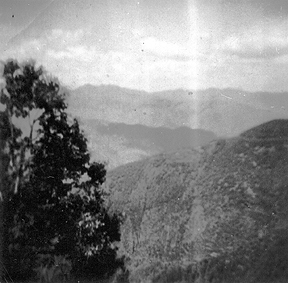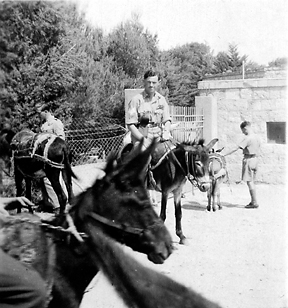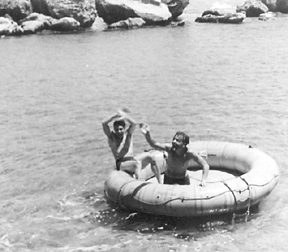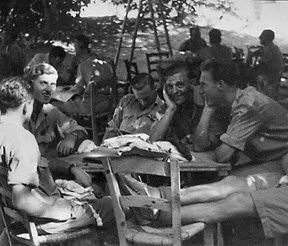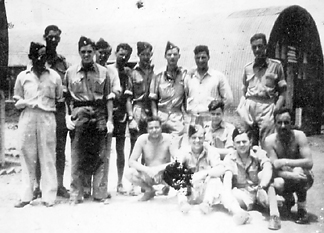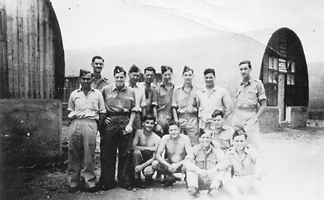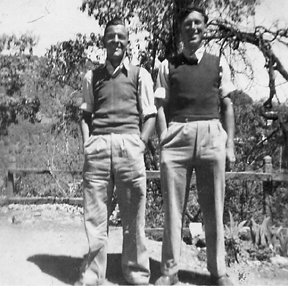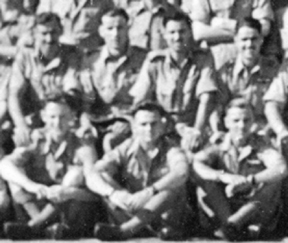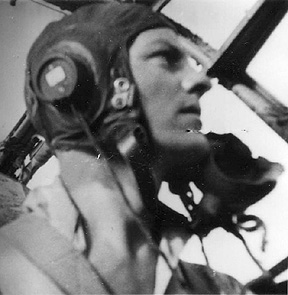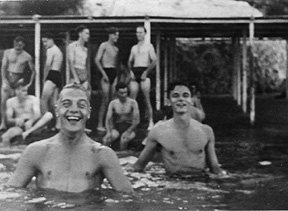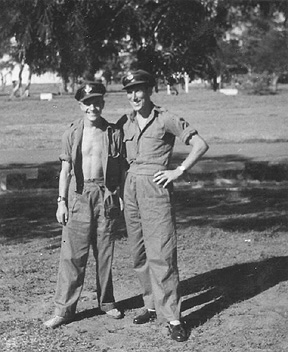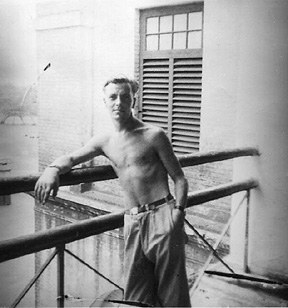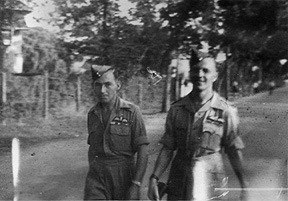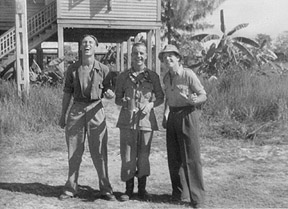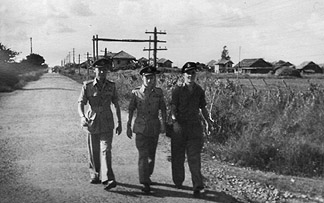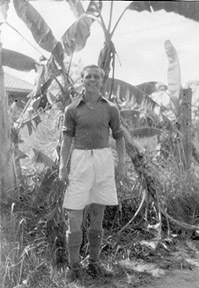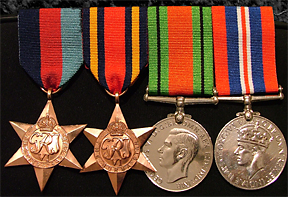 |
 |
|||||||||||||||||||||||||||||
|
Warrant Officer Thomas Dalziel Taylor 1561496 RAFVR 1922—2004 Young Tom Taylor hailed from Greenock on the Clyde, where he was born in the Spring of 1922. In late September 1941, an apprentice draughtsman not yet 20, he presented himself for enlistment in the RAF. On assessment by his local Selection Board (No 24 ACSB), he was found medically fit. Perhaps with credit accruing from his education and trade, he was recommended for aircrew training as pilot or observer.
A happy studio shot for the family before departure, trainee aircrew flash already in his cap. Like many another as the RAF struggled to cope with the influx of new recruits, he was attested, attached to Edinburgh Reserve with the usual entry level of Aircraftman 2nd Class, and then sent home. Ever the serviceman’s lot: hurry up and wait. Into the RAF In the air The system then shuffled LAC Taylor quickly through No 1 Aircrew Despatch Centre at Heaton Park and 51 Group Pool (the portal for aircrew training). From there, real flying beckoned with posting to 4 Elementary Flying Training School, Brough. By now it was 4 August 1942. The very next day he was in the front seat of a Tiger Moth at last. A fortnight later, LAC Taylor had some 12 hours dual in the log as pilot under training. The Empire Air Training Scheme, known in Canada as the British Commonwealth Air Training Plan, was already well underway in the summer of 1942. A year on from his enlistment, Tom Taylor had now passed the first hurdle: the twelve hour EFTS stint had been put in place that year to grade pupil pilots, the better ones being sent on to Canada for their aircrew training. A grand adventure no doubt, but plucked out of Brough, he languished at the Aircrew Despatch Centre once more from 15 September 1942, apparently embarking for Canada on 13 November. O Canada! If rather galling after such a long layoff, perhaps it was as well that the system now required him to start again at the beginning. At 31 EFTS De Winton, south of Calgary in chilly winter Alberta, he began afresh in Course No 70. Repeating the Tiger Moth elementary flying exercises he had flown 4 months before, within a fortnight he’d got his confidence back, the all-important first solo carefully underlined in the log on 19 December, after only six hours in the air in Canada (eight was expected). There was still plenty of dual instruction to go. By 5 February 1943 Tom Taylor had completed his 8 week course with 28 hours dual and 42 hours as pilot by day, plus 15 hours dual night and instrument flying. The log now recorded a total of 87 flying hours overall, and 12 unappealing hours shut in the dark cabin of the Link Trainer, that first of flight simulators. LAC Taylor passed out of Elementary Flying School with the usual dry assessment of ability as a pilot: “average”. Though unremarked in his remaining papers, Taylor was now slated for multi-engine training, rather than the single engine stream for potential fighter pilots. With scarcely a break, his advanced training began on 7 February 1942, in the Avro Ansons of 33 Service Flying Training School at Carberry, Manitoba, on the transcontinental railway 180km west of Winnipeg. In passing the twelve weeks of Course No 74, Taylor had added to his Log Book a further 106 hours dual instruction (70 by day, and 36 at night or on instruments), plus 71 hours as pilot, 10 of them at night. Not to mention a further 20 hours in the Link. And so, after 6 months hard work through the winter of 1942, Tom Taylor had earned his flying badge—with effect from 27 May 1943. The step up to Sergeant which came with his wings is recorded on his RAF Form 543A, virtually illegibly in the Promotions table but clearly under Musterings, as Pilot S [ie Sgt] 28 May 1943.
Here the trainee pilots have put up their wings at last, and so recently that the white cap flash of the trainee is still in place while some of the men are still LACs, indicating this is the pilots course completion shot at 33 SFTS. Tom Taylor is in the rear row, third from the left. Front row centre, fourth from the left, is plainly Ken Webster, who on the original is marked with a cross, as are 10 others. They may all be mates of Tom Taylor’s, though it is possible that, like Corky Webster, they were all lost on active service. This copy from the remaining family collection was cut down from a larger print, of which Monty Walters kept a copy, shown below.
The full print from Monty Walters, of the trimmed version seen above. The newly qualified pilots have their wings, but still retain the white cap flash of trainees. All but three are still Leading Aircraftmen at this point. Personnel names, as sorted by Messrs Walters and Watts: Front row: fourth from the left, LAC Ken (Corky) Webster With the early summer of 1943 came the first of the “polishing” steps. At 31 General Reconnaissance School, Charlottetown (on Prince Edward Island in the southern waters of the Gulf of St Lawrence), Sgt Taylor dashed though the notionally 9 week navigation course in 6 weeks. Flying Ansons for 38 hours as second pilot, he was learning the black art of dead reckoning navigation on long over water legs, so essential for coastal reconnaissance work or ferry flights from the UK. Monty Walters kept a print of their Course photograph, seen on Ricky Watts page. Course complete, by 2 August 1943 it was time to go home, some eleven months after leaving the United Kingdom. After a week’s leave, he was at 31 Personnel Depot, Moncton on the icy Bay of Fundy in New Brunswick, awaiting embarkation. Back in the UK From some reason there was now a hiccup: posted this time to 21 Pilots Advanced Flying Unit at Perton in Wolverhampton from 15 February. In the Reserve Flight, he kept his hand in with just 15 hours flying from then until April. This too may have been a little galling. Perhaps it was something to do with the difficulties encountered in setting up No 79 Operational Training Unit in the Middle East. Although formally established in February 1944 to train general reconnaissance and strike crews on Beaufighters, the state of the airfield and consequent delays in taking aircraft on charge meant it was May 1944 before training could begin. In the Middle East In Cyprus on 8 August he at least got a seat in an aircraft type that had not long been withdrawn from operational duty: the Bristol Blenheim V. With three weeks of dual refreshers in a big twin under his belt, he was finally introduced to a first-line operational aircraft, the Bristol Beaufighter X. With a further 17 hours in the Link Trainer (true “dual” then being impractical in the Beaufighter) and a couple of one hour “over the shoulder” stints, on 3 September 1944 he strapped in to the cockpit for his first solo in the mighty “Beau”. By 23 September, he had teamed up with Sgt Vic Broome as his Navigator/Wireless Operator and they were in serious business, just on three years since he had enlisted. In 3 Squadron of 79 OTU, formation flying practice came first, then more exciting action: lots of air to ground gunnery with the crashing, reeking cannons under their feet, and more smoke and thunder with RP (rocket projectile) attacks. On 23 October 1944, the Beaufighter course completed, Taylor had 480 service flying hours under his belt, 54 of them in the Beaufighter.
A day off on the beach at Tel Aviv. Only five of the seven are identified on the print. Tom fourth from the left, rear. Identified in full by Ricky Watts and Monty Walters in 2010 as follows: In India Earlier in the war, many men had long delays in India while getting to their intended units. Now, after the apparently interminable training and transit camps, the steadfast patience of Flight Sergeants Taylor and Broome was to be rewarded—they were about to move quite smartly to the sharp end. First came a quick refresher course for Taylor. It being some 10 weeks since he had flown, five Beaufighter flights at No 3 Refresher Flying Unit, Poona, got him back into the swing of things in the last two weeks of the year. Then on with Vic to the Ground Attack Training Unit at Ranchi, where 211 Squadron had been based and where the earlier Beaufighter crews had gone through similar training under the Special Low Attack Instructors School title. Arriving on 12 January 1945, they completed a dozen flights in fourteen days, adding 24 hours to the log, 23 as pilot for Taylor. Taylor scored well with his guns and rockets, gaining a “good average” assessment for both. At last, the long, long months of training were done. They were ready for operations. To 211 Squadron At this time the Squadron was replacing a number of tour-expired men who had completed 200 hours flying on operational sorties. Thus W/O Bill Dickinson had left that same day, while W/O Dennis Spencer had departed three days earlier. On 16 February, attached to ‘B’ Flight under the Australian Perce Stacey, they took a local flight around Chiringa for an hour in Beaufighter X KW398 ‘S’. By late March, some other old mates from 79 OTU had turned up, with the arrival of Monty Walters and Ron Kemp. Beaufighter operations By the end of March, with F/Lt EL Wood temporarily in charge of the Flight, they had already accumulated 11 operations in 49 flying hours, returning safely from the tenth on one engine after being shot up. This was sufficiently diverting that Taylor later could not recall the full identity of the aircraft, only noting it in his log as RD...‘X’. The ORB recorded the events: Form 540 Monthly Summary The end of Beaufighter operations was nearly upon them now. In April they added 3 more operations, and on 3 May one final railway patrol and that was that: 15 operations in all, in 67 flying hours. Along the way, Taylor had accumulated some 585 service flying hours in the Log Book. On 28 May 1945, Taylor was promoted again, to the “war temporary” rank of Warrant Officer. Mosquito conversion The first accident took place while the Squadron was based at Yelahanka. In the course of a fighter affiliation exercise on 29 June, W/O Lowcock lost control of HR554 while manoeuvring at an altitude of 2000ft and was unable to recover. The aircraft crashed on a local village near the airfield and caught fire on impact, killing Lowcock and W/O Bill Wilkes, and 38 villagers. Taylor was taking part in this exercise, sitting in the second seat alongside the very experienced W/O Alan Wythe DFM in RF588. The second accident occurred three days later. On 2 July, RF779 crashed in the course of a formation shallow dive-bombing display 28 miles North of Bangalore and perhaps 10 miles north of Yelahanka. Sadly, the pilot 1455066 W/O Kenneth Webster misjudged the pullout and the aircraft disintegrated on impact with the ground. Webster and his navigator 1550365 F/Sgt Jack Hopes died. Webster was a particularly close friend of Tom Taylor’s. By this date, Taylor was already at St Thomas Mount, and on that day he was in the air, doing a dual check with F/Lt Winship at the controls of Mosquito III RR277. These incidents deeply affected Taylor and indeed the whole Squadron. But in August the end of the war came, to much celebration. The Japanese surrender forestalled the resumption of operations towards which they had been working for their part in Operation Zipper (the invasion of Malaya planned for that month). To Siam Sadly, it was in the course of communications sorties out of Don Muang that the Squadron’s last casualty was to arise, when RF588 broke up in mid-air 10 miles SSW of Ipoh in Malaya on 13 December 1945 with the loss of F/O Stephen Falconer Dunnett 179774 and his passenger. Dunnett would certainly have been known to F/Sgt Taylor, though as an officer, perhaps not so well as other NCO aircrew. The Squadron remained at Don Muang until March 1946. Despite repeated restrictions, stand-downs and inspections of their aircraft and the possibility of disbandment, they carried on with the routine of a Squadron at operational readiness, carrying out a range of flying exercises designed to keep their skills up and “show the flag”, lest they be needed to mount sorties against Communist insurgents. On 19 January 1946, the Squadron took part in the grand parade and flypast for the returning King of Siam, HM Ananda Mahidol, Rama VIII with SEAC Supremo Lord Mountbatten, well recorded by Squadron members including Ron Kemp, Des Marsh-Collis, Les Ramsay, and Monty Walters,whose photographs show the 12 aircraft formation in which Tom Taylor took part. The 211 Squadron contingent of nine aircraft was led by S/Ldr FM Bruckshaw and included Taylor and Broome flying RF765 ‘S’. The Spitfires of 8 Squadron and 10 Squadron were a little off in their lining up, so the 211 Squadron formation was the only one to track over the saluting base in Rajadamnoen Ave, timed to arrive as the RAF contingent (including 211 Squadron groundcrew) passed HM the King and Mountbatten. Now more problems were found with the aircraft, as recounted on the Mosquito page. With it, came the final disbanding of a valiant Squadron. On 25 February 25 1946, Tom Taylor and and Vic Broome flew RF791 from Bangkok to Singapore for disposal, their last flight together with No 211 Squadron RAF. The Log Book now stood at 661 hours service flying, 418 as pilot, 67 on operations, and 47 in the Mosquito. The Squadron disbanded on 15 March 1946. A brief sojourn Towards the end of his overseas service some light relief came Taylor’s way, with a final relaxed posting to the AHQ Burma Communications Flight at Rangoon. Although he made no more entries in the log book beyond a tantalising incomplete mention of Spitfire FS364, the one line entry of his final RAF flying assessment on the 25 May 1946 Air Headquarters Burma chit says it all: “A good average pilot”. Duty done Tom Taylor’s Photographs
The white flash of the aircrew trainee in their caps, Taylor on the left with a friend. Perhaps at Brough, but possibly Canada. If so then very likely 31 Elementary Flying Training School at De Winton in Alberta—as cold as his Scottish home.
A happy shot of a newly qualified pilot
A spot of leave at the seaside, perhaps in May 1944. By this date the tide of war had changed and with it came a palpable sense of optimism. More hard fighting was still to come and bitter losses too, but few doubted the ultimate outcome.
An anonymous shot. There were a number of familiar ex-Blenheim Squadrons in theatre that re-equipped with the Republic Thunderbolt in 1944 or 1945, among them 30 Squadron, 60 Squadron and 113 Squadron.
A very early shot. Kenneth had joined the RAFVR in February 1942. Selected for aircrew he took initial training at London, Brighton and Aberystwyth, before gaining his pilot’s wings as another BCATP trainee in Canada. Posted to Coastal Command he had gone on to serve in the Middle East, before reaching 211 Squadron in India. He was just 22 when he died in the accident to Mosquito RF779 on 2 July 1945 recorded above. He lies, with his Nav/W Jack Hopes, in Madras War Cemetery. Webster and and Taylor were very close mates.
Ken’s elder brother Vincent had joined the then Auxiliary Air Force in 1939. Volunteering for aircrew, by 1943 and aged about 26, he had been posted to 35 Squadron then operating from Gravely as a Pathfinder unit equipped with the Handley Page Halifax II. On the night of 17/18 August 1943 he was lost on the historic Peenemünde raid in Halifax II HR862 TL-X. Of the large force of 600 Halifax and Lancaster aircraft striking the German Army Research Centre V2 rocket testing site that night, 41 aircraft were lost, 18 of them Halifaxes. Webster’s aircraft crashed near Greifswald on the Baltic coast of NE Germany, about 15 miles (about 4 minutes flying time) SW of the target, killing five of the seven crew. Two survived, as PoWs. Webster and his four dead comrades were initially buried at Greifswald and later, fittingly, moved to the Berlin 1939-1945 War Cemetery, a site selected soon after the war by the Commonwealth War Graves Commission and British Occupation Authorities. The two Webster boys are commemorated in the Totley Rise Methodist Church, the local Totley war memorial, and of course by the Commonwealth War Graves Commission.
Pilot F/Sgt L Wagstaff 1801570 on the right, his Nav/W JL McCaskill 1578901 on the left. In new overalls—one of a number of photographs of crews, sporting the new overalls acquired from the off-base tailor at St Thomas Mount, taken in mid or late 1945, including Monty Walters and Ricky Watts. All had completed their Beaufighter training at 79 OTU Cyprus. The two crews Wagstaff and McCaskill, and Walters and Kemp, joined the Squadron together on 19 March 1945. Les Wagstaff and Mac McCaskill carried out 11 operational sorties together in March and April 1945 and remained with the Squadron until December 1945.
A spot of leave at one of the Hill Stations of Northern India. Mussorie is in the foothills of the Himalayas, 220 kilometres north of Delhi. Known for its 5,000 year old Hindu temples and cool climate and still a tourist destination today.
More holiday entertainment, perhaps also in the Hill country.
Here the lads have a shady spot for the afternoon, at ease reading papers or just skiting. TD Taylor centre, looking at the camera.
Tom Taylor third from the right, front row, elbows on knees, and possibly Vic Broome standing third from the left. At Chiringa there were no Nissen huts. Some of the men are shirtless, suggesting somewhere in the Far East or India, though the presence of so many forage caps and the absence of any bush hats is puzzling. It might be Ranchi and the Ground Attack Training Unit, where there were indeed Nissen Huts. Taylor and Broome took their final polishing there in January and February 1945. But then, it might just be later—W/O Taylor was posted to 110 Squadron in 1946, another Mosquito unit. This might just be at the permanent pre-war station in Malaya, RAF Seletar.
Same occasion, but Taylor now seated second from the right, front row. Possibly Vic Broome standing third from the left.
From the large official group shot (where Taylor is 12th from the left, front row). Here he is the rightmost figure. Photographs of Tom Taylor
In the cockpit, but neither Mosquito nor Beaufighter. This has the look of a Blenheim, and TDT is a picture of concentration at the controls. Taken from the bomb-aimer’s position, by the looks.
Relaxing in the pool. Tom on the left.
The popular new uniforms, again at St Thomas Mount.
Another relaxed off duty shot.
Two pilots. "Alfie" grins warily at the camera, Tom smiles widely. The collected ribbonry suggests a latish date, probably at Don Muang.
A cheerful shot, Tom with tankard to hand as they carol happily away.
Walking down from Don Muang airfield to catch the bus to Bangkok.
Tom was goal-keeper in the Squadron soccer team. Home to Greenock Tom died on 4 February 2004 at his Golf Club. Much missed, he rests on Lyle Hill overlooking Greenock Golf Course, the River Clyde and on North to the mists of the Highlands. With great generosity, Frances and her middle son Eric have gone to much trouble in offering copies of Tom’s Log Book, his Form 543A Service record, and his remaining photographs and other treasures to make the writing of this narrative possible. His Log has also added much to the record of 211 Squadron Beaufighter and Mosquito aircraft.
A record of proud service: the 1939—1945 Star, Burma Star, Defence Medal and War Medal. Sources www.211squadron.org © D Clark & others 1998—2025 |
|||||||||||||||||||||||||||||
